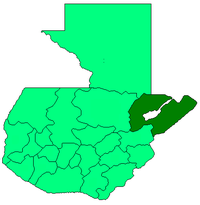by Global Good News staff writer
Global Good News Translate This Article
18 May 2008
Speaking recently on Maharishi's Global Family Chat, Raja Jose Luis Alvarez, Raja of Latin America for the Global Country of World Peace, reported on the new programme to create invincibility in Guatemala that has started in the town of El Estor.
Guatemala has population of 30 million and requires 400 Yogic Flyers to create invincibility for the nation. Guatemala is a country of the Mayan culture, which is a very old tradition in that part of the world, and the traditional people have a deep knowledge of Natural Law.
Raja Jose Luis reported that a few months ago an understanding was reached with the Spiritual Association of the Mayas of Guatemala for national invincibility, and the leadership appointed two brothers who have been instrumental in implementing the programme for invincibility in El Estor.
Raja Jose Luis showed slides of El Estor, which has a beautiful lake in the very spiritual area of the Mayas in central Guatemala. The programme for Consciousness-Based Educationhas started in three schools with about 500 students. A fourth school is also planning to start a programme with 500 students.
On the basis of this, the community of El Estor have decided that the families—the farmers and the wives of the farmers—are going to gather as a group of 2,000 people every day, over and above the children in the school, to create this effect of invincibility for Guatemala.
Teachers of Transcendental Meditation came from Mexico and also from Italy, and have been working very diligently to create and inspire the Mayan leaders to start these Mayan schools in Guatemala. 'As a result, when they learn the Transcendental Meditation Sidhi Programme, the number of meditators is enough to create invincibilty for Guatemala,' said Raja Jose Luis.
Raja Jose Luis said that some of the leaders of the Mayas have very deep knowledge. The Mayan calendar, which is a very sophisticated, mathematical calendar, describes very clearly the same values of Sat Yuga, the new Age of Enlightenment, [as in the Vedic tradition].
'It is in this view they receive us,' said Raja Jose Luis, 'and in this view they understood that this is not just the teaching of the technique in the school, it represents a transformation of a time that they have been looking forward to.'
Raja Jose Luis showed slides of the children and also said that when they are receiving the lectures, and when they are meditating, the people feel it's similar to some of the intricate knowledge they have of Natural Law. 'They feel it is just supported in something they have started to forget and is now being re-enlivened in their culture, in their way of being, their way of feeling, and in their way of behaving,' Raja Jose Luis said.
He reported that between May and June they 'expect to have Yogic Flyers in Guatemala, now that we have enough meditators meditating together.'
Raja Jose Luis also reported that there has been a change in government in Guatemala, which has brought the idea to these families in El Estor that 'We are a small country, but we also want to have a Maharishi Tower of Invincibility.' So they are organizing the land, the funds, and all that is necessary to accomplish this.
There is also interest in the government, Raja Jose Luis said. 'We'll now be reporting from Guatemala . . . and once the Mayas have enlivened Natural Law there, we have to create a Tower of Invincibility in Guatemala very soon.'
El Estor
From Wikipedia, the free encyclopedia
This article does not cite any references or sources. Please help improve this article by adding citations to reliable sources. Unsourced material may be challenged and removed. (August 2007) |
Before roads and railroads, Lake Izabal was the link between Alta Verapaz and the rest of the world. What is now known as "El Estor" was the landing and trading post for cargo and travelers to frontier towns such as Cobán. Commonly referred to as "the store" in English, the name evolved to its present form due to Spanish-speakers style of pronunciation and spelling.
Recent construction of roads has left El Estor a minor port visited mostly by locals and the adventurous traveler.
The population of El Estor consists largely of Kekchi speaking indigenous people.
| |||||||||||||||||||||||||||||||||||||||||||||||||||







